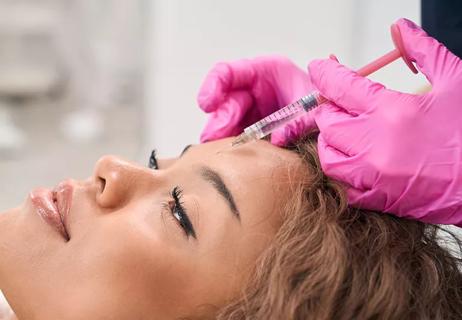A plastic surgeon explains your cosmetic injection options

If you’ve ever wished you could smooth those little worry lines across your forehead or the laugh lines around your mouth, you might have considered cosmetic injections or even surgery.
Advertisement
Cleveland Clinic is a non-profit academic medical center. Advertising on our site helps support our mission. We do not endorse non-Cleveland Clinic products or services. Policy
Before you think about going under the knife, it’s important to know that tried-and-true gold-standard injection options and newer dermal fillers can provide a natural, youthful effect — no surgery required.
Plastic surgeon J. Vicente Poblete, MD, says cosmetic injections can be a good way to minimize wrinkles without turning to invasive procedures. He explains some of the most popular options and answers your most pressing questions.
Botox®, or botulinum toxin A, prevents the flexing of muscles that cause wrinkling, like in your forehead and around your eyes and mouth.
Originally used to treat muscular conditions, Botox is among the most well-known cosmetic injections. It’s a neurotoxin that affects the nerves, temporarily weakening the muscles that cause wrinkles and resulting in a temporary smoothing effect.
Other U.S. Food and Drug Administration (FDA)-approved medications like Dysport®, Xeomin® and Jeauveau® work similarly. But Botox is the market leader, with about 90% of treatment targeting the upper face. “We prefer it because it’s predictable and we know it works,” Dr. Poblete says.
It’s approved by the FDA for treating laugh lines, crow’s feet, forehead lines and the creases between the brows, sometimes called “11 lines.”
Advertisement
Anyone over 18 can receive these injections, but most people are 30 to 60 years old.
Although it can also be used as a preventive measure to delay some wrinkles from developing, it’s not a great idea. “I tend to discourage patients from using it for that,” Dr. Poblete says, “because when the lines aren’t there yet, it’s difficult to gauge its effectiveness.”
“Getting Botox is a quick outpatient procedure performed with a fine needle,” Dr. Poblete says. “You should see the full effect within three days to a week.”
Think of Botox like a haircut: The effects don’t last forever, and in time, the effects wear off. After four to six months, your muscles will begin regaining movement, and your wrinkles will start returning.
It’s safe to have Botox done again.
“Aging is a deflationary process,” Dr. Poblete says. That means that as people get older, they tend to lose fat in their faces. Dermal fillers are used to help restore the look of fullness that’s common in youth.
Enter dermal fillers such as Juvederm® and Restylane®, which can temporarily mimic the return of the facial structure of your youth by adding volume. (There are other varieties of fillers, too. The product your doctor chooses is largely dependent on the area they’ll be treating.)
Fillers are commonly used in the depressions around the corners of the mouth and cheekbones. One of the most popular uses of dermal fillers is lip fillers, which use synthetic hyaluronic acid to increase the volume of your lips. Juvederm is also approved for infraorbital hollows and the chin/lower face area.
“Most dermal fillers last anywhere from nine to 12 months, depending upon the patient and where we’re targeting the injections,” Dr. Poblete says. Juvederm Vollure® and Voluma® last closer to 15 to 18 months.
In short, they treat different types of lines.
Botox prevents the flexing of muscles that cause wrinkling, while dermal fillers fill in the type of wrinkles that come from a loss of collagen, volume and elasticity. “The lines in the lower part of the face aren’t due to repeated muscle movement,” Dr. Poblete explains. “They come from a change in facial structure over time.”
Because they focus on different parts of your face, it’s possible to get both Botox and dermal fillers, or to get more than one type of filler.
“Usually it’s best to get a combination of different fillers to get optimal correction,” Dr. Poblete says. “Together, Botox and dermal fillers can work together to rejuvenate the face.”
Advertisement
In 2015, the FDA approved Kybella®, or deoxycholic acid, as a nonsurgical treatment for addressing neck fullness or fat, known as the double chin. This treatment can be a good alternative to liposuction, as long as you’re willing to have multiple treatments and willing to wait several months for the final results.
But it takes some time to take effect. The treatment consists of receiving two to three injections about four to eight weeks apart. It works best for people with mild to moderate fullness and not too much excess skin. If the skin is too loose, no injection can tighten it.
“Any cosmetic injection treatment has potential side effects,” Dr. Poblete says. “It’s best to talk with your doctor about the specific injections you’re receiving, as side effects may vary.”
You should also have a thorough discussion with your doctor to understand what’s realistic in terms of results. It’s important to know that you aren’t going to get facelift results from nonsurgical treatments like Botox or dermal fillers.
“They can’t replace surgery,” Dr. Poblete says, “but they can improve your appearance.”
Advertisement
Learn more about our editorial process.
Advertisement

Here’s why you may want to consider getting a filler for those pesky bags under your eyes

Most recommended precautions center around minimizing bruising or swelling

Most recommended precautions center around minimizing bruising or swelling

With repeat injections over time, you may be able to slow the development of new wrinkles

The cosmetic injection may help train your muscles out of frowning, but there’s no hard data to say for sure

One reduces wrinkles by relaxing muscles; the other adds volume and smooths skin

The big difference with this procedure is the smaller dosing

The benefits go beyond cosmetic enhancements

Type 2 diabetes isn’t inevitable with these dietary changes

Applying a hot or cold compress can help with pain